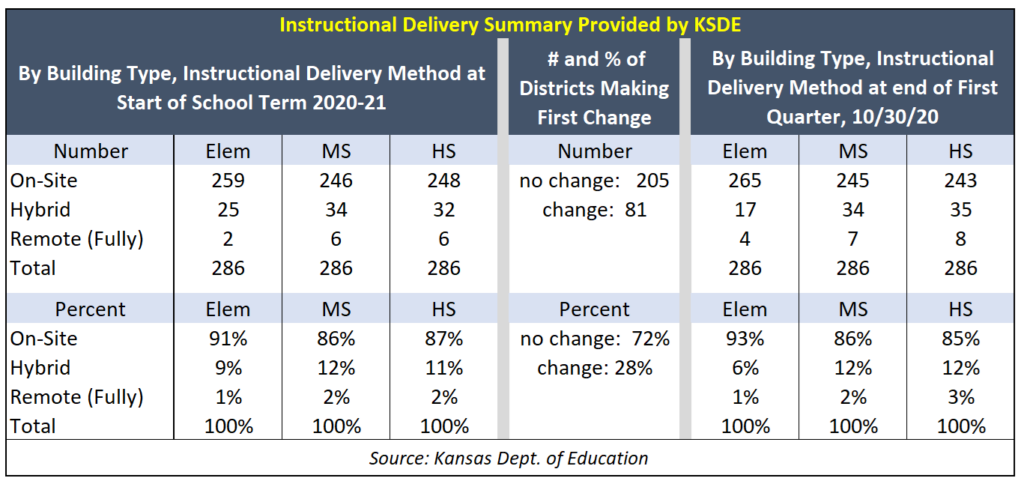Hybrid and remote learning is taking a toll on Kansas students, parents and kids told the House K-12 budget committee last week.
“I’m here today not as a proponent or opponent of any bill, but because I don’t know what else to do,” Jennifer Whitlow, a parent of students enrolled in the Gardner-Edgerton School District, told the committee. “My children have not seen the inside of a classroom for 11 months.”
Kansas Gov. Laura Kelly closed Kansas schools for the remainder of the school year on March 17, 2020.
Many Kansas students today are attending school in person, full-time. When the new school year started last fall, most districts opened their doors to students full-time. By the end of the first quarter, 265 of the state’s 286 districts offered full-time in-person learning for elementary students, 245 districts for middle school, and 243 districts for high school. Only seven districts are still only offering remote learning for middle school, and eight districts for high school.

The Kansas Department of Health and Environment and some county health departments established arbitrary recommendations for gating criteria last summer. The guidelines are based on a variety of metrics, often including COVID transmission rates and positivity rates within a community. For instance, under the Johnson County Department of Health and Environment guidelines, all students are in remote learning if 15% of those being tested pop positive and rates are increasing. When the rolling 14-day positivity rate dips below 10%, the criteria recommends that middle and high school students use hybrid learning models. Below 5%, the county guidelines say it’s safe for all kids to return to school in person. Johnson County’s rolling positivity rate sits at 6% today, after peaking at 15.5% in November. It was last below 5% at the end of June.
Strict reopening metrics keep some schools closed
Joy Eakins, a Wichita district school board member, owns a data company that studied gating criteria in surrounding states. Kansas standards suggest that if there are more than 150 COVID cases per 100,000 residents then students shouldn’t be in classrooms. In Kansas’s less populated counties, that shutters school buildings with 10 cases or fewer.
“On all counts, we have the most restrictive gating of all states surrounding us,” she told House K-12 budget committee members.
KDHE’s gating recommendations are more stringent than Johnson County’s. As of Feb. 24, only 24 of Kansas’s 105 counties meet the positivity rate criteria for full-time, in-person learning. The Kansas Legislature adopted language late last spring allowing Kansas counties and school districts to opt in to pandemic-related executive orders. Kelly can’t unilaterally close the schools again without consent from school boards and county officials, but full school re-opening is moving too slowly for many of the parents and students who spoke to legislators last week.
David Brucker, the parent of a Blue Valley School District student, said early data concluded that COVID-19 was more deadly and more contagious than it turned out to be.
“We are not today where we were in March, but we are still in the same place as far as education. Why?” he asked.
Brucker said the district isn’t living up to its slogan.
“I live in and pay for the Blue Valley School District. I moved to this district for “Education
beyond Expectation”. Today I only get “Silence beyond Belief”. This is unacceptable.”
Dave Trabert, CEO of Kansas Policy Institute (the Sentinel’s owner), shared 26 pages of quotes from students and parents, citing serious and negative consequences of hybrid and remote learning. Some of the quotes came from videos of school board meetings but others were submitted anonymously from parents and kids who feared retaliation from school districts.
The goalposts keep moving
Some districts continually updated metrics to allow for school buildings to open and for students to participate in activities like sports and band. Others, like the Spring Hill School District, tossed out gating criteria entirely and reopened fully on February 1. However, Dr. Christine White, a pediatrician, said she fears the goalposts are moving in the wrong direction toward keeping schools closed.
“My fear is the goalposts for getting kids back in school has been a moving target,” White said. “…Initially, it was OK, we’ll have a few weeks out of school. Then it was, OK, now we’re not going to have school for the rest of the year.”
Later, the state health department, counties, and school districts created gating criteria. White said much of the criteria is unreasonable and communities may not meet the guidelines even by this fall.
“That’s currently the goalpost, but I’m afraid new goalposts will be 50, 60, 70, 80% of the general population vaccinated,” she said. “And then teachers, we’ve got to get teachers vaccinated. Then, students… I fear then it will be the cries of what if this new strain is more deadly. What if? What if? What if? It needs to stop now.”
Dr. Jill Ackerman, a family physician, told the committee that study after study shows schools aren’t major COVID transmitters. She quoted studies from the New England Journal of Medicine, a University of North Carolina pediatrics study, and local and national health officials like the CDC and Johnson County Health Director Dr. Jospeh LeMaster. The data and officials say schools can open safely with face to face learning, Ackerman said. Still, the Blue Valley School District continues to use gating criteria that is more than six months old and still has middle school and high school kids on remote learning.
“Study after study shows by far that if a student or a teacher comes down with COVID, they got it from activities in the community,” White said.
Concerns for how schools will operate once reopened
Scott Boserath’s daughter attends school in the Shawnee Mission School District. The single father works outside the home, and he worries about leaving his daughter alone all day.
“Any legislator, any school board member, any Ph.D. advocating for anything other than opening schools, you are doing a disservice to children,” he said. “I feel like my child is being shorted more than GameStop stock.”
Shawnee Mission schools only offered remote learning during the first quarter of the year. The district used a hybrid model during the second quarter. Boserath said he is happy his daughter is allowed in a school building a few days each week. However, during the other three days, she’s doing nothing.
“They’re given virtual assignments, and other than that, they’re on their own all day by themselves,” he said.
Even when they’re in school buildings, Boserath says the students aren’t able to connect with other students or their teachers.
“They’re so disconnected and so regimented,” he said. “How could you feel comfortable asking your teacher for help on a math problem when your teacher is behind a shower curtain or plexiglass?”
Only two kids are allowed to use the bathroom at a time so Boserath says his daughter is afraid to use the restroom. She’ll end up in a long line and miss 20 minutes of class.
“In the lunchroom, even the teachers said it sounds like a prison. You can’t go find a friend and talk to the one person you know,” he said.
His daughter’s favorite class is choir, but they aren’t doing concerts. In class, the students sing for 20 minutes, but they need two fans running and the students wear masks.
“It’s a travesty. What’s happening is causing so much fear, anxiety, depression, and self-worth issues,” he said.
Doctor says remote learning impacts student mental health
In her medical practice, White used to see 2-3 kids per week suffering from anxiety, depression, or suicidal ideations. Now, she told the committee, she sees 2-3 kids per day with mental health issues.
“Every day I see kids who have just given up. Every single day, I see kids with severe anxiety. They’re fearful. They’re scared about their future, their health. Depression, I also see on a daily basis,” she said.
She asked legislators to do something.
“If there is anything you guys can do from a legislative standpoint to get these kids back in school now or back in the fall, I beg you to do it,” White said. “We’ve got to ensure these kids have the best chance to learn and grow and develop and in some cases, give them the best chance to live.”




